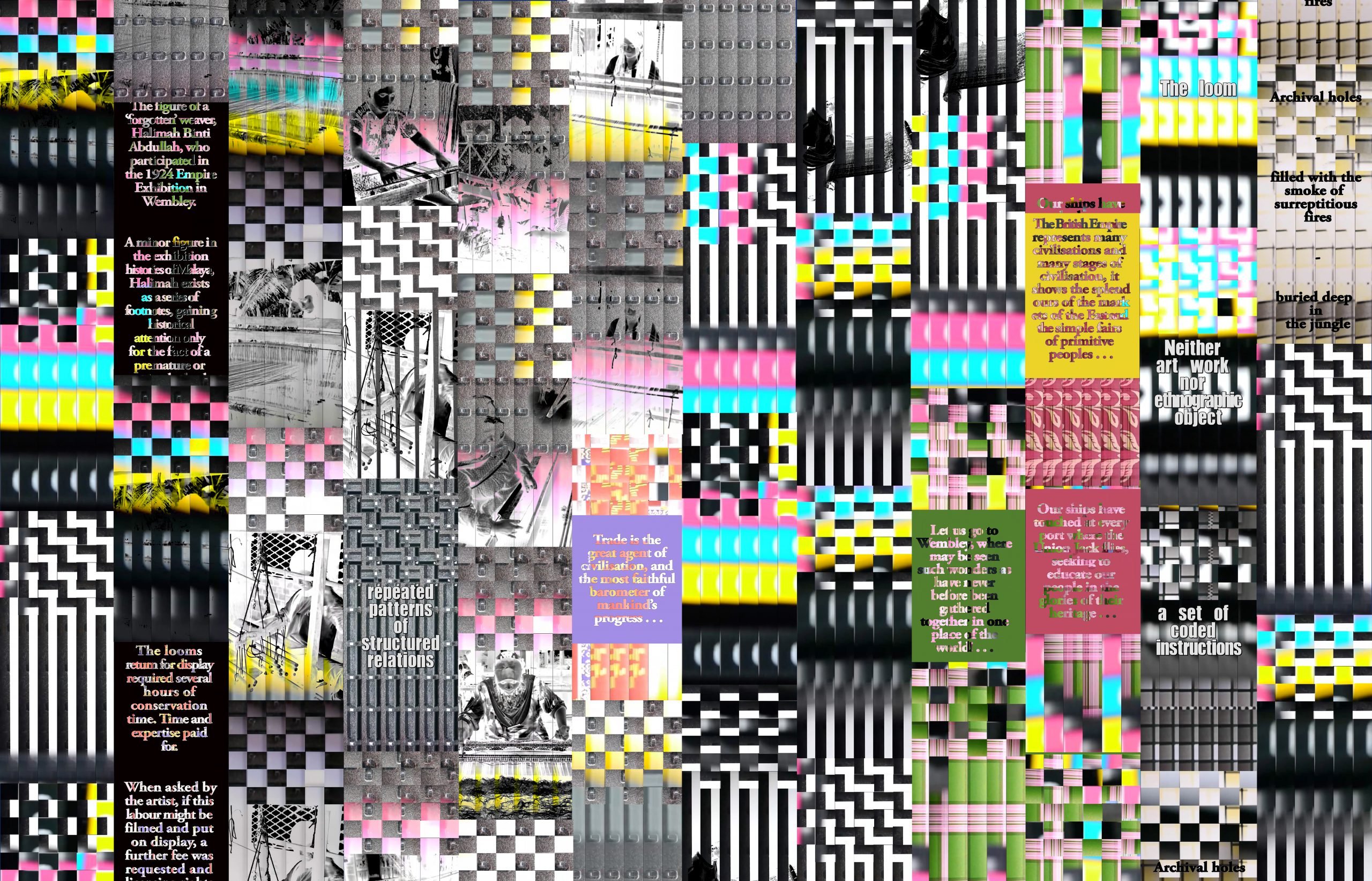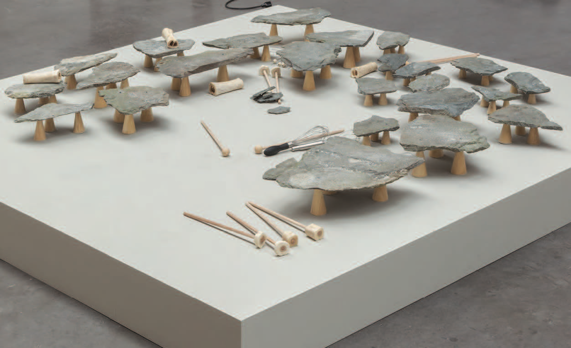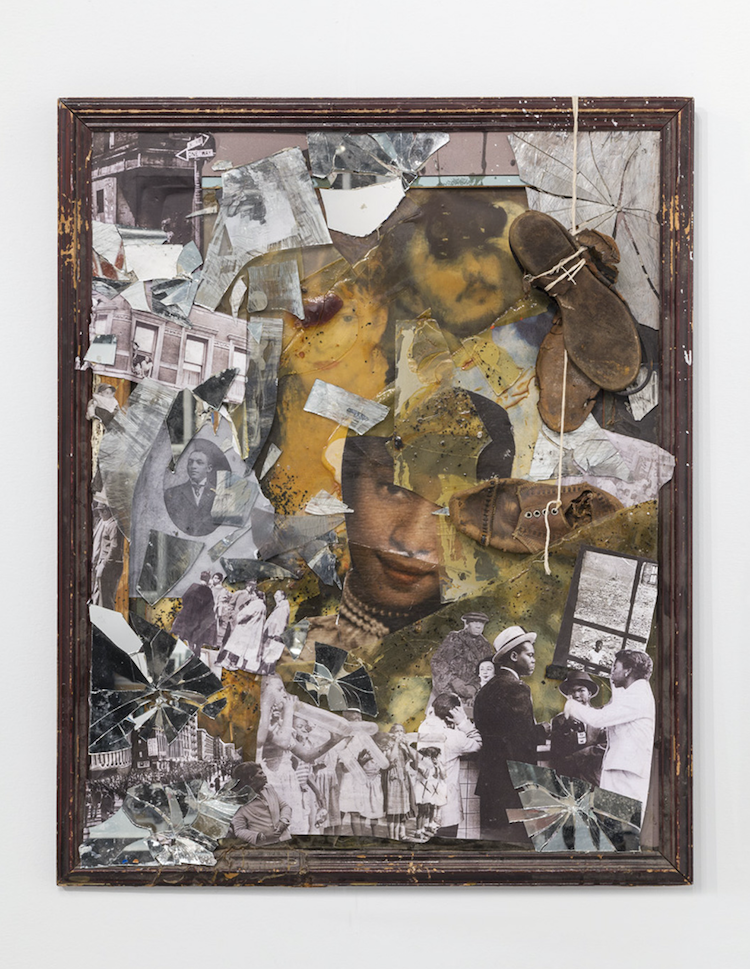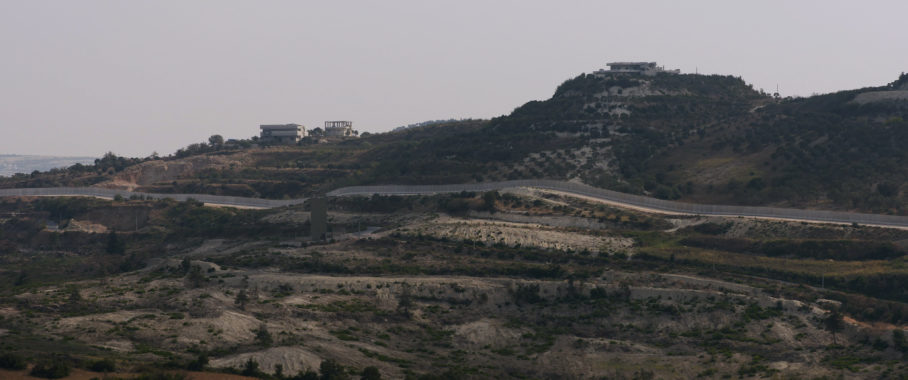
© » KADIST
Gozo Yoshimasu
Drawing & Print (Drawing & Print)
Gozo Yoshimasu’s double-sided work on paper Fire Embroidery explores his response to the March 2011 Tohoku earthquake and tsunami. He embarked on the project out of a deep sense of sympathy and commitment, in pursuit of “poetry possible after March 2011”, without exactly knowing where he was heading. He started scribing lines and letters on exceptionally large manuscript paper that he handcrafted every day.

© » KADIST
Joana Hadjithomas & Khalil Joreige
Produced for the Prix Marcel Duchamp and presented at the Centre Pompidou in October 2017, the installation Uncomformities is comprised of photographs, archaeological drawings, and narratives, based on the analysis of core samples from different sites in Beirut, Paris and Athens. The work questions how, at a time when traces and memories no longer exist, and the earth remains the only witness of our past, history is produced, and how the stories of our civilization are written and told. In each location, the artists collected soil samples, which they asked experts to analyze before creating a series of narrations and coded drawings.

© » KADIST
Erika Tan
APA JIKA, The Mis-Placed Comma is one of three works Erika Tan filmed within exhibition spaces during the final stages of their transition from colonial period law courts to the National Gallery Singapore. Part of an on-going body of work, this video focuses on the figure of a forgotten weaver, Halimah Binti Abdullah, who participated in the 1924 British Empire Exhibition in the United Kingdom. A minor figure in the exhibition histories of what was formerly known as Malaya (today, Singapore and Malaysia), Halimah exists as a series of footnotes, gaining historical attention only for the act of a premature death from pneumonia, in London and away from home.

© » KADIST
Bady Dalloul
Drawing & Print (Drawing & Print)
geopoliticalThe Great Game is a series of works composed of a number of card combinations illustrated by the faces of key political figures shaping the geopolitical landscape in the Middle East. Each reconstituted ‘hand of play’ corresponds to a diplomatic treaty establishing or modifying geographical borders. The plastic form of a poker hand chosen by the artist highlights the randomness of the process of fixing boundaries and the way in which they do not account for the lives of those located there.

© » KADIST
Clarissa Tossin
Clarissa Tossin’s film Ch’u Mayaa responds to Frank Lloyd Wright’s Hollyhock House (constructed 1919–21) in Los Angeles, an example of Mayan Revival architecture. By re-appropriating the structure as a temple and imbuing it with a dance performance based on movements and postures found in ancient pottery and murals, the choreography takes its influence from the house’s design and the body positions on ancient Maya ceramics and buildings. A pulse, breathing, and a pre-Columbian clay flute are among the sounds on the soundtrack.

© » KADIST
Sky Hopinka
Dislocation Blues by Sky Hopinka is a portrait of the 2016 Standing Rock protests against the Dakota Access Pipeline in South Dakota. Working against grand narratives and myth-making, Hopinka attempts to provide a clear look towards the participants of the protest movement and the protectors of the water – their testimonies, reflections, and histories. In the film, Cleo Keahna tells about the everyday life of the camp and its difficulties and Terry Running Wild shares his dreams for the future.

© » KADIST
Rocky Cajigan
From the Ending by Rocky Cajigan consists of an assemblage painting, with accompanying sculptural objects presented on the floor. The bright pink object central to the painting is based on a photograph, and the artist’s personal memory, of a Bontoc ancestral tomb, commonly located at close proximity to a family home. The painting is covered by a net material simulating a fence, creating a certain bodily distance from the viewer’s perspective.

© » KADIST
Jackie Karuti
The Planets, Chapter 32 (2017) is a short video that depicts the world at a time of great anxiety. However, it is done with a sharp sense of humor. It starts with a voice explaining that Africa will be partially inundated in the coming year, ending with the impossible relationship between the artist and a chatbot (primitive form of artificial intelligence).

© » KADIST
Curtis Talwst Santiago
Curtis Talwst Santiago has been creating intimate and performative environments within these small spaces for several years; the artist used to carry them around to show visitors one on one, opening up a scene in the space of his hand. Santiago considers these mobile box enclosures a method of transporting narratives of home and intimacy, diasporic identity, and experiences most often hidden or concealed from view. These Walls is a sculptural piece made from a reclaimed jewelry box, clay, paint, wool, plastic figurines, and human hair.

© » KADIST
Diamond Stingily
Dad is Byron is an audio work produced in collaboration between Diamond Stingily and her father, the house musician Byron Stingily. Viewers are invited to pick up a wall-mounted telephone that has been retrofitted to play a recording of a conversation between Stingily and her father. Although initially the artist planned to focus on her father’s recollections of the violence during his childhood in Chicago in the 1960s and how music helped him cope, the conversation has a natural and intimate meandering.

© » KADIST
Randa Maddah
Shot from the rooftop of her house in Majdal Shams, through a complex construction of moving mirrors, this video connects both sides of the border which has cut through Syrian Golan heights since the 1967 Six-Day war. Located on the cease-fire line, residents of Majdal Shams are reminded of this tragic separation on a daily basis. During the war the majority of the local population were exiled to Syria.

© » KADIST
Doreen Lynette Garner
Known But to God: The Dug Up, Dissected, and Disposed for the Sake of Medicine by Doreen Lynnette Garner is a small, suspended sculpture composed of glass, silicone, steel, epoxy putty, pearls, Swarovski crystals, and whiskey. At once attractive and repulsive, the sculpture combines objects of adornment with what appears to be viscera. The sculpture’s curious delicacy evokes a ritualistic catharsis, in response to persistent forms of medical racial violence and objectification for Black people in America and around the world.

© » KADIST
Michael Rakowitz
The Ballad of Special Ops Cody by Michael Rakowitz is a serio-comic stop motion animated film in which an everyday African-American G. I. character, personified through an action figure that comes to life. The protagonist breaks into Chicago’s Oriental Institute to “liberate” Mesopotamian votive statues, who are likewise animated through voice-over narration, from their imprisonment in the museum’s vitrines. This set-up allows for meditations on various war and colonial histories; as a barbed twist on the Bush-era rhetoric of promoting “democracy” in the Middle East through regime change, the G. I. cannot understand why the statues wish to remain in the museum and not return to their (currently war torn) “homelands”.

© » KADIST
Kiri Dalena
Gikan Sa Ngitngit Nga Kinailadman (From The Dark Depths) by Kiri Dalena is a stylistically collaged film inspired by the true story of a young activist’s drowning. Moving between reality and fantasy, it depicts the story of a dead communist who sinks to the bottom of the ocean into a dreamlike subaquatic utopia. In the film a young woman mourns the death of an activist that took place years ago.

© » KADIST
Diego Marcon
Monelle by Diego Marcon was filmed at night inside the infamous Casa del Fascio, the headquarters of the local Fascist Party in Como Italy, designed by Giuseppe Terragni under Mussolini’s rule. The building is immersed in darkness and it is initially difficult to recognize the iconic rationalist architecture, flashes of light illuminate languid adolescent girls sleeping amidst the space for just a few seconds at a time. Next to the bodies, strange humanoids are lurking, they are CGI-generated, but the human eye does not have enough time to register their artificiality, they materialize and disappear in a flash like ghosts.

© » KADIST
Erbossyn Meldibekov
Game (Six Pieces) by Erbossyn Meldibekov is inspired by the popular Rubik’s cube puzzle and is composed of three colors (red, green and white) instead of six, referencing the colors of the Afghan flag. The work provides a revisionist interpretation of the legacy of The Great Game (the original 19th-century standoff between Russian and British empires over Afghanistan), and Afghanistan’s position as a centerpiece of the longstanding War on Terror, (the military campaign led by the United States and their allies against organizations and regimes they identified as terrorists after 9/11). Game (Six Pieces) mobilizes dark humor and irony to illustrate the complex and unstable relationships between communism, Islam, and American and British imperialism.

© » KADIST
Karan Shrestha
After the decade-long conflict (1996-2006) that ended with Nepal becoming a Federal Democratic Republic, political unrest and weak governance continued to mark the country’s future as daily life repeatedly witnessed ruptures. From accessing essentials to employment, education, compensation, legal justice, health facilities, and human rights, the people of Nepal have been forced to wait. Meanwhile by Karan Shrestha records moments of impasse as the post-conflict period dragged on.

© » KADIST
Imran Qureshi
At first glance, This Day by Imran Qureshi appears to be an energetic, gestural painting reminiscent of Action Painting from the mid-20th century. But upon closer inspection, highly detailed floral elements reveal themselves amongst the bold red brushstrokes. The botanical motifs in Qureshi’s work represent life and regeneration while the red paint refers to death and mortality.

© » KADIST
Ilana Bar
One of Ilana Bar’s best-known works is the series Transparências de lar (Home Transparencies) in which, for four years, the artist photographed her family’s rural home in Atibaia where her father lives with his two brothers and Ilana’s own brother, all three with Down Syndrome. Transparências de lar is the record of a serene, though certainly not a perfect, place. In this place Down Syndrome is not considered an alienable difference in the way that it is in Western culture, it is not problematic or a cause for social exclusion.
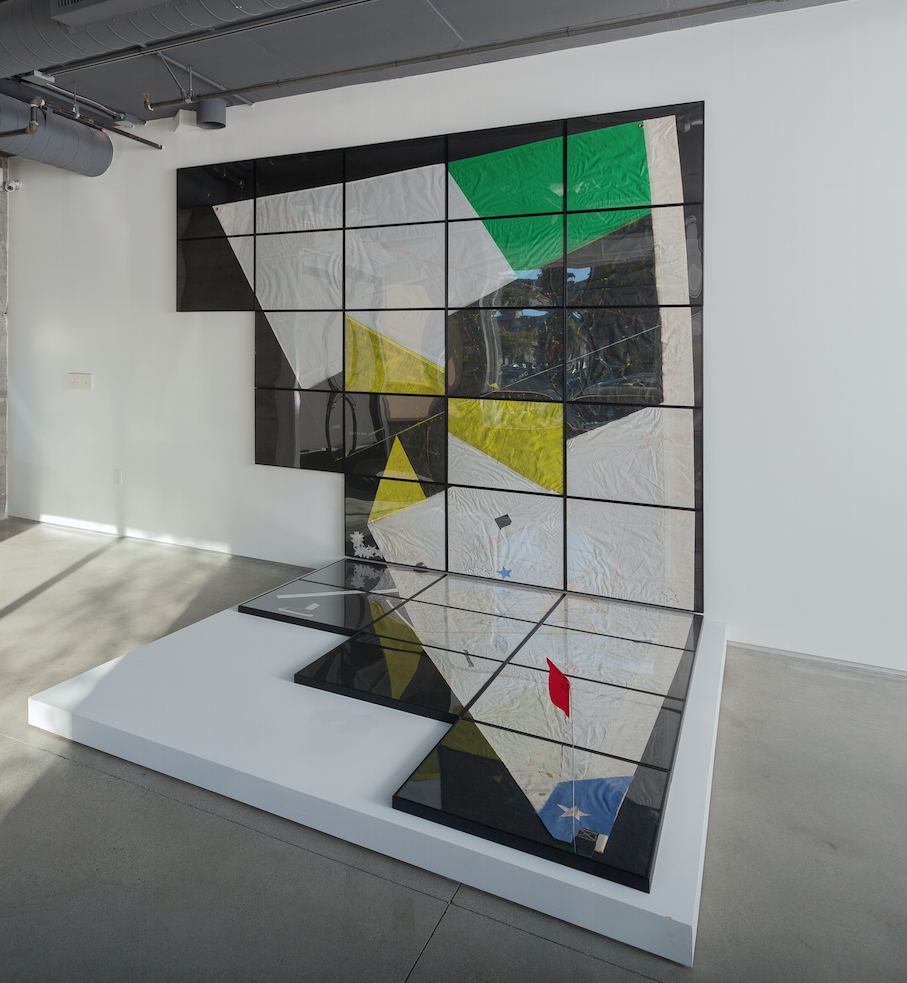
© » KADIST
Enrique Ramirez
Ramirez’s The International Sail is the fifth in a series that features an upside-down worn out, mended and fragmented boat sail. These works epitomize the idea of perpetual movement and migration while carrying a deep personal meaning in the creative process, as the artist’s father himself, still living in Chile, mends and sends the sails to his son, living in Europe. The reversed position of the sail recalls both the shape of South America itself and the Eurocentric view that in the Southern Hemisphere, everything is “upside-down.” The stitches themselves create an illusion of an alternative political geography, and the framed-cuts impose a cartographic grid.

© » KADIST
Lim Sokchanlina
The photographic series Wrapped Future II by Lim Sokchanlina brings fences used on construction sites to enclose the surrounding areas, to different locations, lakes, valleys and forests; and places them at the center of works to obscure the beautiful Cambodian landscape. The inharmonious landscape is gradually captivated by the exquisite balance between inorganic material and mystical background. The photos were taken in places that in recent years have become targets of large-scale exploitation under a massive globalization of capital and other political interests.

© » KADIST
Curran Hatleberg
Untitled (Man with Bees) is part of Curran Hatleberg’s attempt to make sense of the current state of the “American Dream”, or lack thereof. “Without question our present American experience feels increasingly strange, unnerving and dreamlike. Our country is utterly different and changed now in its present iteration – surreal and confounding – and we can’t help but regard it with a confounded stare that we hold in reserve for the most bizarre and difficult circumstances.” This image is one, like many in the series that find something poetic, supernatural, and surreal in the common human condition of middle America.

© » KADIST
Andrey Shental
Descent into the Fungal is a two-channel video and a sculptural installation. The mushroom / sculptural element is site-specific and is grown from readymade mushroom blocks sold by mushroom farmers. They are given two weeks to mature and follow their natural cycle, bringing the natural element directly into the white cube.

© » KADIST
Etel Adnan and Lynn Marie Kirby
Drawing & Print (Drawing & Print)
In conjunction with KADIST’s 2017 exhibition If Not Apollo, the Breeze , artist and filmmaker Lynn Marie Kirby performed Transmissions , a video and live reading created with longtime collaborator Etel Adnan. Inspired by time spent together in Paris, the piece incorporated open-ended conversation about the oracle, Mount Tamalpais (a subject of long-standing fascination for Adnan and the subject of hundreds of works), and a suite of collaborative drawings. The drawings, made in India ink and created spontaneously, are remarkable evidence of two lives, minds, and hands in dialogue.

© » KADIST
David Horvitz
The title of the work Eridanus refers to the constellation of the river of ancient Athens that meanders across in the night sky. The constellation is visible uniquely from the Southern Hemisphere. The artist evokes a story from the past, where with the installation of modern street lamps, has resulted in the residents of Paris being disturbed by the difficulty of seeing the stars in the sky as a result of light pollution.

© » KADIST
Kapwani Kiwanga
Kapwani Kiwanga’s Linear Painting series (2017) reflect the artist’s research into disciplinary architecture, including schools, prisons, hospitals, and mental health facilities. When they were presented together, the paintings were arranged according to a black horizontal line placed at 160 centimeters from the floor, which traced the entire perimeter of the gallery. According to hygiene standards in Europe, this would mark the height below which walls should be washed in order to prevent the spread of illnesses.
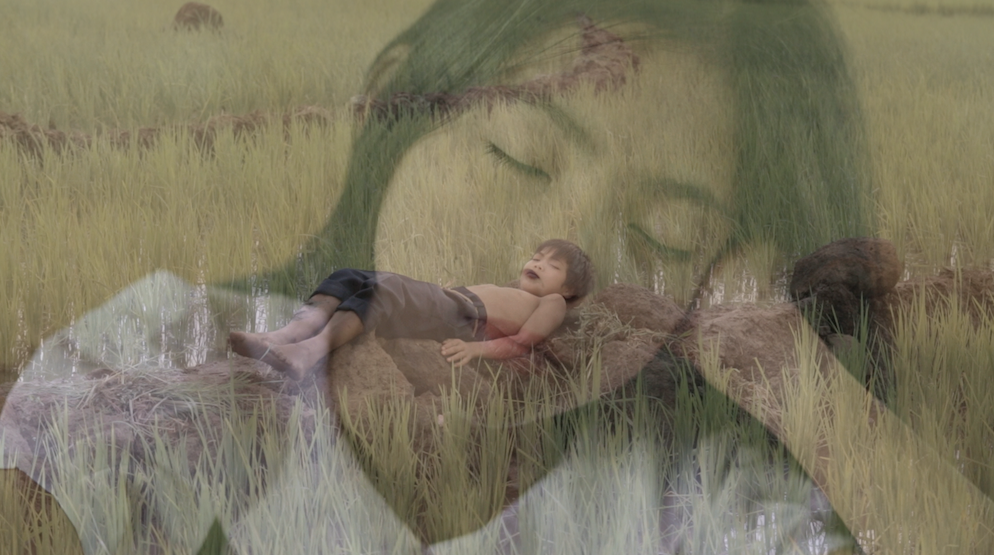
© » KADIST
Phan Thao Nguyên
Tropical Siesta begins in a rural landscape of Vietnam. Very quickly, painted images of students sleeping on their school benches appear. A text speaking of how the communist regime has placed agriculture at the center of its economy reads alongside the images.

© » KADIST
Wolfgang Tillmans
Wolfgang Tillmans initiated the ongoing series Faltenwurf in 1989, representing compositions of unused clothing, with special attention paid to the ways in which they drape and fold. The title is taken from a Germanic term used in the context of art history, designating classical drapery. In this particular photograph, Faltenwurf (Stairwell) , an assortment of various colored clothes lay tangled on a set of stairs, as a sculpture of abstract forms.

© » KADIST
Pio Abad
Comprising two sculptures, one photograph and one video, the installation Malakas & Maganda (1986 – 2016) questions the mythological iconography of the Filipino conjugal dictators Ferdinand and Imelda Marcos and thus addresses the construction of propaganda representation and the role of art facing current events. The work is organized around the leftovers of a copy of a monumental sculpture of Imelda Marcos, which the artist had commissioned and whose remains were stored in his studio. Several included elements show how this body of work has evolved over time and in reaction to political events in the Philippines.
Lim Sokchanlina
Lim Sokchanlina, nicknamed ‘Lina’, works across documentary and conceptual practices with photography, video, installation, and performance; particularly drawn to the use and function of space where urban communities meet rural attitudes...
Bady Dalloul
Bady Dalloul cunningly employs collage across various media: texts, drawings, video, and objects to produce powerful works commenting on the past and the present...
Erika Tan
Erika Tan’s practice is primarily research-driven with a focus on the moving image, referencing distributed media in the form of cinema, gallery-based works, Internet and digital practices...
Rocky Cajigan
Rocky Cajigan is a Bontoc Igorot artist working in the contemporary contexts of Indigenous people from the Cordilleras region in the northern state of Luzon island in the Philippines...
Joana Hadjithomas & Khalil Joreige
Joana Hadjithomas and Khalil Joreige collaborate as both filmmakers and artists, producing cinematic and visual artwork that intertwine, spanning feature and documentary films, video and photographic installations, sculpture, performance lectures and texts...
Kapwani Kiwanga
Kapwani Kiwanga is a contemporary researcher, installation, video, photography, sound and performance artist currently based in Paris...
Baseera Khan
Designed by the artist and fabricated in collaboration with Kashmiri artisans, Baseera Khan’s Psychedelic Prayer Rugs combine visual iconography traditional to Islam, such as the crescent moon and lunar calendar, with brightly colored symbols of personal significance to the artist: a pair of embroidered sneakers, a fragment of an Urdu poem, and the Purple Heart medal...
Ilana Bar
Ilana Bar is a Brazilian artist, photographer and researcher...
Etel Adnan and Lynn Marie Kirby
Visual artist, poet, and essayist Etel Adnan writes what must be communicated through language, and paints what cannot...
Sadie Benning
When she was fifteen Sadie Benning’s father gave her a kiddie PixelVision camera, a device that recorded grainy black-and-white video on standard audio cassettes...
Khvay Samnang
Khvay Samnang’s work critically examines the interlocking nature of ritual and politics, the humanitarian and ecological impacts of globalization, colonialism and migration, and the cultural-material histories of exchange that have shaped the Southeast Asia region...
Danielle Dean
Danielle Dean creates videos that use appropriated language from archives of advertisements, political speeches, newscasts, and pop culture to create dialogues to investigate capitalism, post-colonialism, and patriarchy...
Pio Abad
In his practice, Pio Abad looks into the social and political significance of objects usually consigned to the sidelines of history...
Sinzo Aanza
Sinzo Aanza is a visual artist, poet, and playwright...
Wong Kit Yi
Wong Kit Yi’s conceptual and performance-based work animates human interactions by measuring, locating, and quantifying the intangible...
Kiri Dalena
Kiri Dalena is an acclaimed visual artist, filmmaker, and activist...
Jean Claracq
Jean Claracq uses his work to deal with issues of loneliness in the social media era, depicting scenes of everyday life featuring isolated individuals against broad infrastructures as an evocation of alienation...
Otty Widasari
Otty Widasari is an artist that started her professional career as journalist and got engaged in the media activism and documentary filmmaking...
Rebecca Quaytman
In her work, Rebecca Quaytman displays great interest in the dissolution of the image...
Jackie Karuti
Jackie Karuti is an artist based in Nairobi, Kenya...
Laura Gannon
Laura Gannon works across a range of media: painting, drawing, sculpture and video...
Chikako Yamashiro
Chikako Yamashiro engages with political and social histoires of Okinawa to create haunting works drawing on oral accounts...
Yuichiro Tamura
Yuichiro Tamura works in a wide range of media including video, photography, installation and performance...
Daniel Boccato
The work of Daniel Boccato deals with the relationships between form and language, abstraction and figuration, and forces the viewer to try to name, categorize and differentiate...
Tarek Atoui
Tarek Atoui is an artist and electroacoustic composer working with sound performance...
Duto Hardono
Duto Hardono is a conceptual artist and educator...
Bobo
Bobo is an art collective constituting the artists Nick Payne, Andrew Gillespie, and Phil Cote, and while as a collective entity they are relatively new to the art world, they have been highly influential to many younger NY artists...
Abigail DeVille
African American artist Abigail DeVille’s large sculptures and installations reflect on social and cultural oppression, racial identity, and discrimination in American history...
Laura Rokas
Laura Rokas is a painter, ceramicist, and textile artist...
Eric Baudelaire
Currently based in Paris, Franco-American artist Eric Baudelaire has developed an oeuvre primarily composed of film, but which also includes photography, silkscreen prints, performance, publications and installations...



